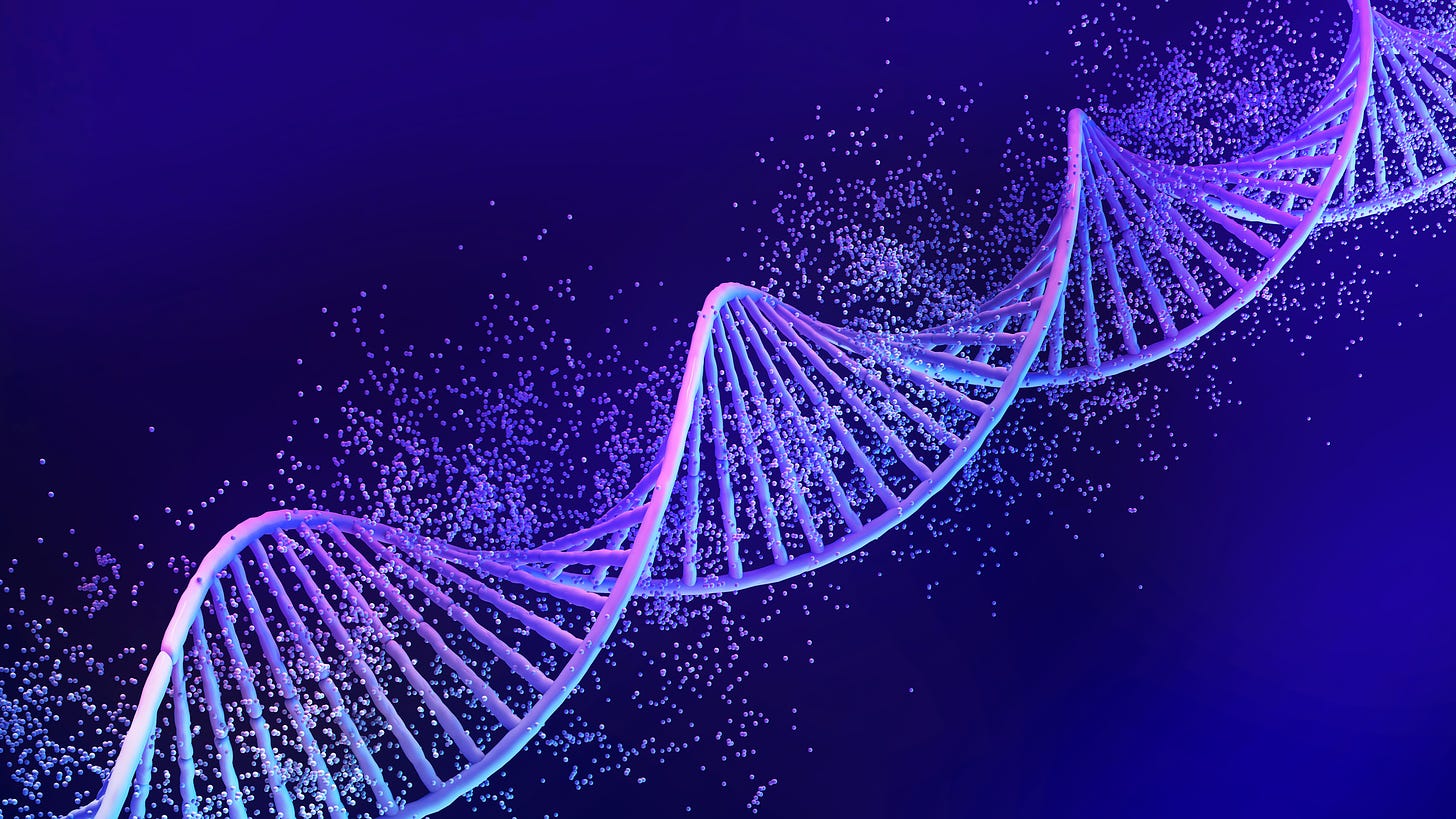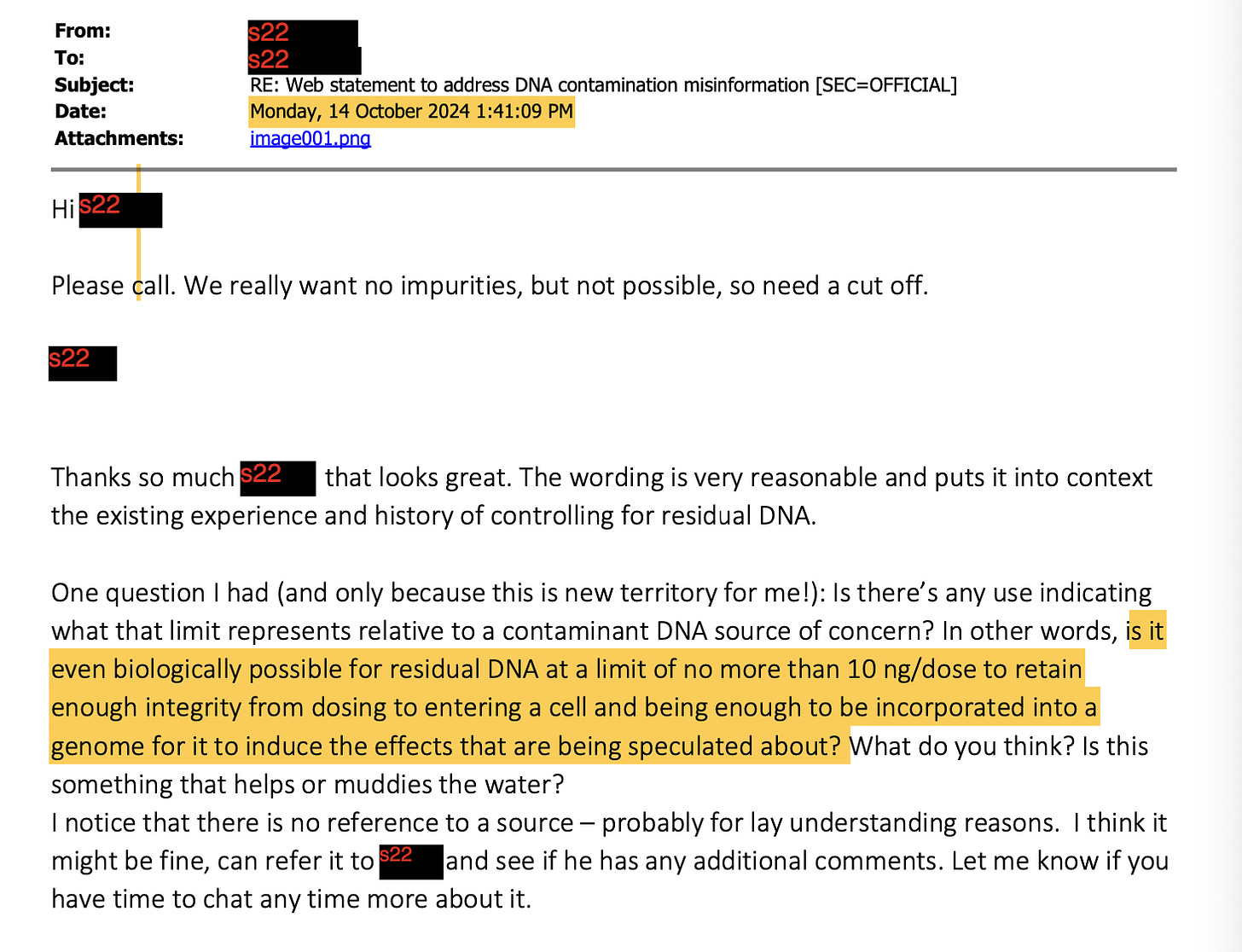BOMBSHELL: Australian drug regulator knows DNA fragments in mRNA vaccines can enter nucleus and integrate into genome, internal emails show
The Therapeutic Goods Administration withheld information on DNA contamination risks from the public, presenting a picture of certainty where there is none
Internal emails from the Therapeutic Goods Administration (TGA) reveal that the regulator withheld knowledge of DNA contamination risks relating to the modRNA vaccines from the public, presenting a picture of certainty on safety where there is none.
Released under Freedom of Information (FOI), the cache of emails shows that high-level TGA staff knew elements of the modRNA vaccines can enter the cell nucleus and integrate into the genome, despite the agency’s official line that such events are not possible.
However, TGA personnel appear more preoccupied with “allaying fears in the public” than with investigating the potential risks.
Highlights
TGA staff acknowledge that DNA integration into the genome is possible
The TGA knows that the SV40 enhancer/promoter in the Pfizer vaccine can drag DNA into the nucleus of cells
Pfizer did not disclose the SV40 sequence to the regulator
TGA staff not aware of any testing for modRNA/DNA integration into human genome
On 18 October, the TGA published a statement, ‘Addressing misinformation about excessive DNA in the mRNA vaccines.’
The statement came after the release of a report by Canadian virologist Dr David Speicher alleging the presence of synthetic plasmid DNA fragments in Australian vials of modRNA Covid vaccines at levels of up to 145 times the regulatory limit.
The issue gained national media attention after a vote by the Council of mining town Port Hedland on 11 October calling for the immediate suspension of the vaccines pending an investigation into the DNA contamination, due to the potential risks of genomic integration, cancers, and other long-term health impacts.
The TGA’s statement was littered with false and misleading claims, which have been addressed in detail here. Now, emails released under FOI reveal that the TGA knowingly withheld information on DNA contamination risks from the public.
Involved in these communications were staff from the TGA’s Scientific Evaluation Branch (Toxicology and Biological Science Sections), Pharmacovigilance Branch, Communications team, and even TGA boss Professor Tony Lawler, showing that personnel at the highest levels are aware of the potential risks associated with synthetic plasmid DNA in the modRNA shots.
With thanks to
, whose request for all TGA correspondence related to the production of the webpage and associated social media posts regarding allegations of DNA contamination in modRNA vaccines has further exposed the regulator’s duplicity on this matter.
Yes, foreign DNA can integrate into chromosomal DNA
The TGA has repeatedly stated that modRNA vaccine elements cannot enter the nucleus of cells, nor can they integrate into the genome.
Internal emails show that senior staff within the agency know this isn’t true.
On 14 October, a TGA staffer asks,
“Is it even biologically possible for residual DNA at a limit of no more than 10 ng/dose to retain enough integrity from dosing to entering a cell and being enough to be incorporated into a genome for it to induce the effects that are being speculated about?”
‘Yes, but unlikely,’ is the collective conclusion.
I cannot stress enough how contrary this is to official TGA and Department of Health messaging, which has vehemently denied that genomic integration of modRNA vaccine elements is possible at all.



Initially, one TGA staffer offers the argument touted by U.S. vaccine expert Dr Paul Offit and serially quoted by fact-checkers, including Scientific American, which is that foreign DNA in the modRNA vaccines cannot integrate with human DNA without the presence of an enzyme called integrase. As integrase is not present in mammalian cells, the argument goes, there is no integration risk.
However, TGA colleagues quickly debunk this claim, and it is deleted from the draft memo:
“Foreign DNA can integrate into chromosomal DNA in the absence of an integrase in mammalian cells. This comes from the DNA damage/repair literature where breaks in DNA are repaired through processes called non-homologous end joining or homologous recombination. Exogenous DNA can potentially be incorporated using these processes.”
From the Biological Science Section (BSS), “although unlikely, there are alternative mechanisms for DNA integration.”
And from a Senior Toxicologist,
“We agree with comments raised by BSS that the original dot point on the role of integrases should be deleted. There are papers implying that other enzymes/mechanisms are involved in integrating SARS-CoV-2 sequences into the DNA of human cells (see Zhang et al 2021).”
In the end, the assertion that DNA integration is not possible is dropped from the memo, replaced with a more nebulous statement about lack of evidence:
“There has been no evidence of mRNA vaccines or biological medicines resulting in integration of residual DNA into human DNA genome or causing cancer.”
However, one staffer admits that he or she does not know of any science to support this statement:
"With regard to adding the comment about plasmid DNA entering the human genome, I would be uncomfortable with that as I am unaware of studies which have tested this and so personally I have no experience in the matter."
The Senior Toxicologist suggests that the statement is too speculative and perhaps should be taken out:
“In the event that some aspects of the statement are too speculative, we can also omit the following sentence “There has been no evidence of mRNA vaccines or biological medicines resulting in integration of residual DNA into human DNA genome or causing cancer.””
However, the final TGA memo retains this sentence.

Under FOI request, the TGA could not provide evidence that it had examined any scientific findings related to testing for alteration of the human genome following modRNA vaccination.
Subscribe
‘SV40 enhancer region can promote nuclear transport of DNA’
As covered at length on this Substack, scientists say that the SV40 enhancer/promoter sequence present in the Pfizer modRNA Covid vaccine poses a unique risk for genomic integration and cancer because it is particularly effective at dragging material into the nucleus of cells.
The Health Minister Mark Butler’s official position on the SV40 enhancer/promoter is that,
“The TGA and the Department do not consider the presence of the SV40 promoter to be a safety concern. The SV40 promoter sequence is considered safe and is a common sequence used in biotechnology-based medicines.”
But privately, TGA staff say otherwise.
"The SV40 enhancer region can promote nuclear transport of DNA," writes a staffer in a comprehensive primer on the risks of residual DNA. This is known in the scientific community, but it is the first proof of acknowledgement from within the TGA.
The qualification follows, “Risk that this will happen is low due to low level of DNA. Risk if does happen, low as integration events have low probability.” Note that ‘low probability’ is a different thing to ‘not possible.’
There is no further discussion among TGA personnel about the implications of the SV40 enhancer/promoter dragging vaccine elements into the cell nucleus of vaccine recipients, which, as shown above, officials publicly insist cannot happen.
SV40 enhancer/promoter not disclosed to TGA by Pfizer
We already know that Pfizer did not annotate the SV40 enhancer/promoter on its DNA plasmid map submitted to regulators. In Health Canada emails released under an Access to Information and Privacy (ATIP) request, an official admitted,
“Pfizer has communicated to us recently, that they apparently chose not to mention this information to EMA, FDA or HC at the time of their initial or subsequent submissions.”
Now we have confirmation that Pfizer didn’t mention this gene therapy sequence to the TGA either.
From the emails,
“The plasmid for expression of the Pfizer mRNA was based on a pCMV-TAG vector (I used BLAST analysis of sequence from Mod3 as not all info was placed in the plasmid map provided by the Sponsor),”
and,
“The plasmid also contains a SV40 promoter and f1 ori region (not shown in plasmid map presented by Sponsor but found in BLAST and reported in Speicher & McKernan papers).”
Happy Holidays from the Art of Liberty Foundation!
We Goofed! Our discount code for 20% didn’t work on December 8th so we are extending the 20% discount until midnight on Thursday, December 12th!
Celebrate the season with special discounts:
20% off from December 5th-12th with the code Liberty20
15% off from December 13th-16th with the code Liberty15
10% off from December 17th until Christmas with the code Liberty10
Shop for unique books and gifts now at Government-Scam.com/store and make this holiday season extra special!
















Here we have another steaming bucket of crap from a regulatory entity entrusted with safeguarding public health. Rigorous science has been replaced by "Cross your fingers and hope NOT to die..."